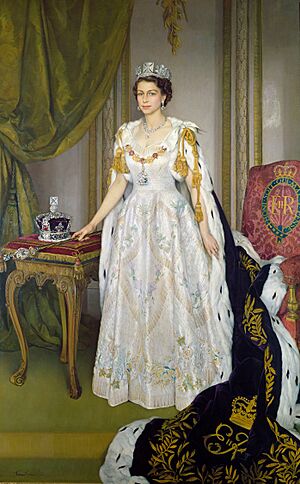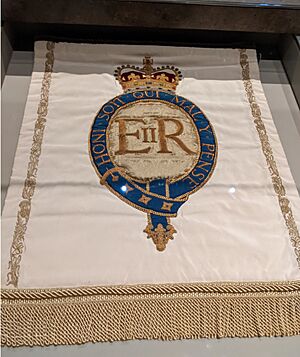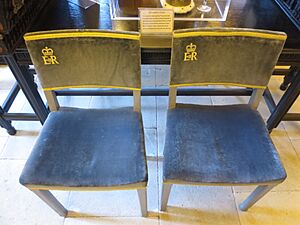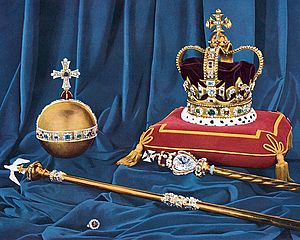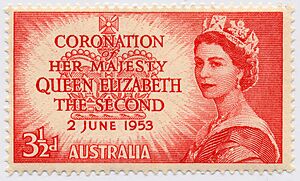Coronation of Elizabeth II facts for kids
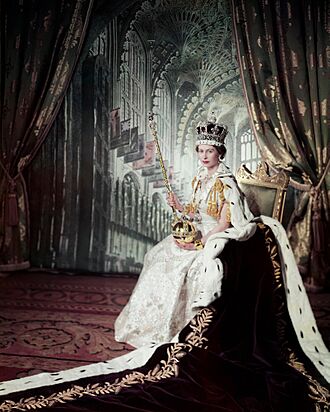
Official coronation portrait taken by Cecil Beaton
|
|
| Date | 2 June 1953 |
|---|---|
| Venue | Westminster Abbey |
| Location | London, United Kingdom |
| Budget | £1.57 million (estimates) |
| Participants |
|
The coronation of Elizabeth II was a special ceremony where she officially became Queen of the United Kingdom and other Commonwealth realms. It happened on 2 June 1953 at Westminster Abbey in London. Elizabeth became Queen when her father, George VI, died on 6 February 1952. She was 25 years old.
The coronation was held more than a year later. This allowed enough time to pass after her father's death. It also gave the planning teams plenty of time to get everything ready. During the ceremony, Queen Elizabeth took an oath. She was anointed with holy oil and given special robes and jewels. Then, she was crowned Queen of the United Kingdom, Canada, Australia, New Zealand, South Africa, Pakistan, and Ceylon (now Sri Lanka).
People across the Commonwealth celebrated this big event. A special medal was also made. This was the first British coronation ever shown fully on television. Cameras were not allowed inside the abbey for her parents' coronation in 1937. Elizabeth's coronation was the fourth and last British coronation of the 20th century. It cost about £1.57 million, which is like £53.5 million today.
Contents
Getting Ready for the Big Day
The coronation ceremony took 14 months to plan. The first meeting of the Coronation Commission was in April 1952. It was led by the Queen's husband, Philip, Duke of Edinburgh. Other groups were also formed. These included the Coronation Joint Committee and the Coronation Executive Committee. Both were led by the Duke of Norfolk. He was in charge of the whole event.
Many physical preparations were needed. David Eccles, the Minister of Works, was in charge of decorations. These were placed along the procession route. Architect Hugh Casson designed street decorations for Westminster. Eric Bedford designed the special Coronation Arches over The Mall.
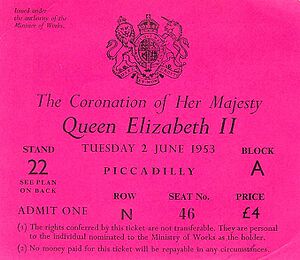
Leaders from other Commonwealth countries were involved in the planning. This showed how important the coronation was around the world. However, some countries chose not to take part in the ceremony itself. They saw it as a religious event mainly for Britain. For example, Canadian Prime Minister Louis St. Laurent said Canada was happy to watch. But they were not direct participants. The Coronation Commission announced in June 1952 that the event would be on 2 June 1953.
Invitations for the coronation were designed by Joan Hassall. She used a special technique called scraperboard. This was because there wasn't enough time for wood engraving. She also designed the personal invitation for Prince Charles.
Norman Hartnell designed the outfits for the royal family. This included Elizabeth's coronation gown. His design for the gown changed nine times. The final dress was white silk. It was embroidered with flowers from Commonwealth countries. These included the Tudor rose for England and the Scottish thistle. It also had the Welsh leek, Irish shamrock, and Australian wattle. There was also the maple leaf for Canada and the New Zealand silver fern. South Africa's protea, two lotus flowers for India and Ceylon, and Pakistan's wheat, cotton, and jute were also included.
Roger Vivier made special gold shoes for the Queen. They had jewels on the heels. Elizabeth chose to wear the Coronation necklace. This necklace was made for Queen Victoria. Other Queens had worn it at their coronations too. She also wore the Coronation earrings.
Elizabeth practiced for the big day with her maids of honour. They used a sheet to stand in for her long velvet train. Chairs were arranged to represent the carriage. She even wore the Imperial State Crown while doing daily tasks. This helped her get used to its weight. Elizabeth had two full rehearsals at Westminster Abbey. The Duchess of Norfolk often stood in for the Queen during practices. Westminster Abbey was closed for five months to get ready.
Queen Mary, Elizabeth's grandmother, died on 24 March 1953. But she had said her death should not stop the coronation plans. So, the event went ahead as planned. The total cost was about £1.57 million. This included stands for 96,000 people along the route. It also covered toilets, street decorations, outfits, and car hire. Repairs to the state coach and changes to the Queen's jewels were also part of the cost.
The Coronation Event
Queen Elizabeth II's coronation ceremony was similar to those of past kings and queens. It was held at Westminster Abbey. Important people like nobles and clergy were there. However, some parts of Elizabeth's ceremony were different.
Watching on Television
Twenty-seven million people in Britain watched the event live on the BBC Television Service. Many bought or rented TVs just for this. The number of TV licenses doubled. This coronation was the first to be fully televised. The BBC's cameras were not allowed inside Westminster Abbey for her parents' coronation in 1937.
There was a big discussion about televising the event. Prime Minister Winston Churchill was against it. But Elizabeth insisted it be shown on TV. It was even filmed with experimental 3D technology. A test in colour television was also shown to children at Great Ormond Street Hospital.
In Europe, this was the first live broadcast from the United Kingdom. New relay links made it possible. The coronation was shown in France, Belgium, West Germany, Denmark, and the Netherlands. This marked the start of Eurovision.
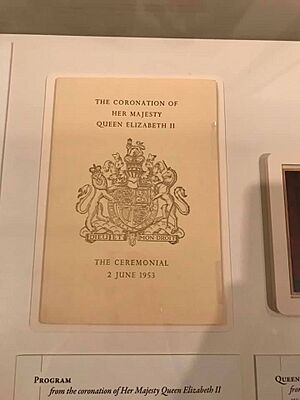
To make sure Canadians could see it the same day, "Operation Pony Express" happened. RAF Canberras flew BBC film recordings across the Atlantic Ocean. The Canadian Broadcasting Corporation (CBC) then broadcast them. These were the first non-stop flights between the UK and mainland Canada. At Goose Bay, Labrador, the film was put onto a Royal Canadian Air Force CF-100 jet. This jet took it to Montreal. Three such flights were made during the coronation. The next day, film was flown to Vancouver. Viewers there could see the coronation, but a day later.
US networks like NBC and CBS also flew films over. But they used slower planes. The ABC network re-broadcast the CBC signal. This allowed ABC to show the event earlier than the other US networks. Viewers in eastern Canada saw the ceremony half an hour before Americans.
Even Australia, which didn't have full-time TV, got the film. A Qantas plane flew it to Sydney in record time. The worldwide TV audience was estimated at 277 million. Also, 11 million people in the UK listened on the radio.
The Grand Procession
About three million people gathered on the streets of London. Some camped overnight to get a good spot. The route was lined with soldiers and airmen from across the British Empire and Commonwealth. Guests and officials passed by in a procession. More than 200 microphones were placed along the path and in Westminster Abbey. 750 commentators broadcast in 39 languages.
The procession included foreign royalty and leaders. They rode to Westminster Abbey in various carriages. Many volunteers helped with this. The first royal coach left Buckingham Palace and went down the Mall. Crowds waved flags and cheered. It was followed by the Irish State Coach. This coach carried Queen Elizabeth The Queen Mother. She wore a crown with the Koh-i-Noor diamond.
Queen Elizabeth II rode through London in the Gold State Coach. Eight grey horses pulled it. The coach had a hot water bottle under the seat to keep the Queen warm. The Queen wore the Robe of State. This was a 6-yard long velvet cloak. It was lined with Canadian ermine. Her maids of honour helped carry it.
The return procession was 4.5 miles long. It passed along Whitehall, through Trafalgar Square, and along Piccadilly. It ended back at Buckingham Palace. 29,000 service members from Britain and the Commonwealth marched. The procession was 2 miles long and took 45 minutes to pass any point. Another 15,800 people lined the route. The parade included colonial groups, Commonwealth troops, the Royal Air Force, British Army, and Royal Navy.
Behind the marching troops was a carriage procession. It included rulers of British protectorates, like Queen Sālote Tupou III of Tonga. Commonwealth prime ministers and royal family members also rode in carriages. The Gold State Coach was escorted by the Yeomen of the Guard and Household Cavalry. Many carriages were needed, some even borrowed from film studios.
After the procession, the royal family appeared on the balcony of Buckingham Palace. They watched a flypast of planes. The flypast was changed due to bad weather. But it still happened as planned. 168 jet fighters flew overhead in three groups.
Important Guests
Westminster Abbey opened at 6 am on Coronation Day. About 8,000 guests were invited from across the Commonwealth of Nations. Important people arrived after 8:30 a.m. These included the Queen's family, foreign royalty, and peers of the United Kingdom. Queen Sālote of Tonga was a guest. She was known for being cheerful while riding in an open carriage in the rain. General George Marshall from the US also attended.
Other important guests included Sir Winston Churchill. The prime ministers of Burma, India, and Pakistan were also there. 129 nations and territories sent representatives. The Queen also hosted two banquets at Buckingham Palace.
The Queen later shared a funny detail. Some nobles had hidden sandwiches under their coronets. This helped them get through the three-hour ceremony. Guests sitting on stools could buy them after the ceremony. The money went towards the coronation costs.
The Ceremony Itself

Before the Queen entered Westminster Abbey, the coronation jewels were carried in. These included St Edward's Crown. The archbishops and bishops of the Church of England waited for Queen Elizabeth II. When she arrived around 11:00 am, her robes made it hard to move. She told the Archbishop of Canterbury, Geoffrey Fisher, "Get me started!"
Once she began, the procession moved inside the abbey. It went up the central aisle. Choirs sang I was glad. Elizabeth prayed and sat on the Chair of Estate. The bishops brought in religious items. These included the Bible, paten, and chalice.
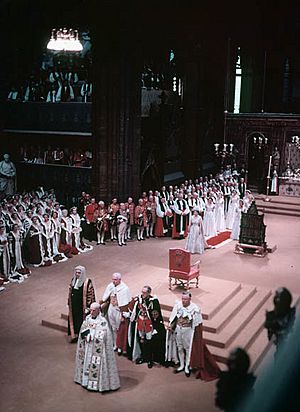
Elizabeth then stood before King Edward's Chair. The Archbishop of Canterbury asked the audience in all directions: "Sirs, I here present unto you Queen Elizabeth, your undoubted Queen: wherefore all you who are come this day to do your homage and service, are you willing to do the same?" The crowd shouted "God save Queen Elizabeth!" each time. The Queen would curtsey in return.
Seated again, Elizabeth took the coronation oath. She swore to govern her countries fairly. She promised to uphold Protestantism in the UK. She also swore to protect the Church of England. She then kissed the Bible and signed the oath. The Moderator of the General Assembly of the Church of Scotland, James Pitt-Watson, presented the Bible to her again. He said it was "the most valuable thing that this world affords."
A communion service followed. Prayers were said by the clergy and Elizabeth. Elizabeth was then anointed with holy oil. The choir sang Zadok the Priest. Her jewellery and cape were removed. She wore a simple white linen dress. She sat in King Edward's Chair. The Archbishop made a cross on her forehead, hands, and chest with the oil. A gold canopy was held over her. At her request, this part was not televised.
Elizabeth was given the Armills (bracelets), Stole Royal, Robe Royal, and the Sovereign's Orb. Then came the Sovereign's Ring, the Sovereign's Sceptre with Cross, and the Sovereign's Sceptre with Dove. With these items, Queen Elizabeth II was crowned by the Archbishop of Canterbury. The crowd chanted "God save the Queen!" three times. A 21-gun salute was fired from the Tower of London.
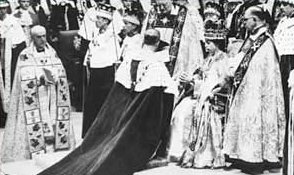
After a blessing, Elizabeth moved to the throne. The Archbishop and bishops pledged their loyalty. Then, the nobles of the United Kingdom pledged their loyalty. This included Elizabeth's husband, uncle, and cousin. After them, five senior nobles pledged loyalty for their ranks.
When the last noble finished, everyone shouted, "God save Queen Elizabeth. Long live Queen Elizabeth. May the Queen live for ever!" Elizabeth then took communion. She recited the Lord's Prayer with everyone.
Wearing the Imperial State Crown and holding the Sceptre and Orb, Elizabeth left Westminster Abbey. The guests sang "God Save the Queen".
Music for the Coronation
William McKie, the abbey's organist, was chosen to direct the music. He had also directed music for the royal wedding in 1947. He formed a committee with Sir Arnold Bax and Ernest Bullock, who had directed music for the previous coronation.
Traditional songs like Handel's Zadok the Priest and Parry's I was glad were included. New music was also ordered from famous composers. Ralph Vaughan Williams wrote O Taste and See. William Walton composed a setting for the Te Deum. Canadian composer Healey Willan wrote O Lord our Governor.
An new idea was to include a hymn for the audience to sing. This was a bit controversial. But Elizabeth liked the idea, so it was added. Vaughan Williams arranged the traditional metrical psalm, the Old Hundredth. It included trumpet fanfares. Gordon Jacob also arranged God Save the Queen with trumpets.
The choir was made up of singers from several cathedrals and chapels. Twenty boy singers were chosen from church choirs across the UK. They trained for a month before the event. The final choir had 182 boy singers and many adult male singers. The orchestra had 60 players. They were top musicians from British orchestras. Sir Adrian Boult conducted the orchestra.
Celebrations and Memories
On the evening of 2 June, the Queen spoke live on radio to thank the public. Celebrations happened across the Queen's realms and the Commonwealth. The British government announced an extra bank holiday on 3 June. The Queen Elizabeth II Coronation Medal was given to thousands of people. Commemorative coins were also made. Canada ordered three million bronze medallions for schoolchildren.
Like at George VI's coronation, acorns from Windsor Great Park were sent around the Commonwealth. They were planted to grow into "Royal Oaks" or "Coronation Oaks."

In London, the Queen hosted a coronation lunch. The famous coronation chicken recipe was created for it. There was also a fireworks show on Victoria Embankment. Many street parties were held across the UK. A football tournament, the Coronation Cup, was held in Glasgow. News that Edmund Hillary and Tenzing Norgay had reached the summit of Mount Everest arrived on coronation day. Media called it "a coronation gift for the new Queen."

In Canada, there were military tattoos, horse races, parades, and fireworks. The country's Governor General, Vincent Massey, made it a national holiday. He led celebrations on Parliament Hill in Ottawa. The Queen's speech was broadcast there. In Newfoundland, 90,000 boxes of sweets were given to children. In Quebec, 400,000 people came out in Montreal. Canadian soldiers in the Korean War fired colored smoke shells and drank rum to celebrate.
A documentary film about the coronation, A Queen Is Crowned, was very popular. It was nominated for an Academy Award. It also won the first Golden Globe Award for Best Documentary Film.
Later Events
On 15 June 1953, the Queen attended a fleet review at Spithead, near Portsmouth. Admiral Sir George Creasy commanded 197 Royal Navy warships. There were also 13 ships from the Commonwealth and 16 from other countries. Britain's last battleship, HMS Vanguard, was present. Four fleet and three light aircraft carriers were also there.
The Queen and royal family reviewed the ships from the frigate HMS Surprise. This was followed by a fly-past of Fleet Air Arm aircraft. 327 planes from 4 naval air stations took part. The day ended with the ships lighting up and a fireworks display.
Honours of Scotland Ceremony

During a visit to Scotland, on 24 June 1953, the Queen attended a special service at St Giles' Cathedral, Edinburgh. There, she was formally presented with the Honours of Scotland. These are the Scottish crown jewels. The service was attended by 1,700 people from all parts of Scottish society. The main part of the event was the presentation of the Honours. The Queen received the Crown of Scotland and then passed it to the Duke of Hamilton. She also passed the Sword of State and Sceptre to other nobles. This ceremony had not happened since 1822.
The Queen wore "day clothes" and carried a handbag. Some Scottish newspapers saw this as a slight. They felt it showed disrespect to Scotland. The decision not to wear formal robes was made to avoid the service looking like another coronation. Scotland had joined with England in 1707. In the official painting of the ceremony, the handbag was not included.
Royal Air Force Review
On 15 July 1953, the Queen attended a review of the Royal Air Force at RAF Odiham in Hampshire. First, different RAF commands marched past. Then, four de Havilland Venom jets wrote the Royal Cypher (EIIR) in the sky. After lunch, the Queen toured a display of about 300 aircraft. She then watched a flypast of 640 British and Commonwealth aircraft. Most of these were jet-powered. The flypast ended with the Venoms spelling out "vivat" (Latin for "long live").
See also
- List of participants in the coronation procession of Elizabeth II
- 1953 Coronation Honours
- The Queen's Beasts, statues representing Elizabeth's family history
- Canadian Coronation Contingent
- Coronation of Charles III and Camilla


